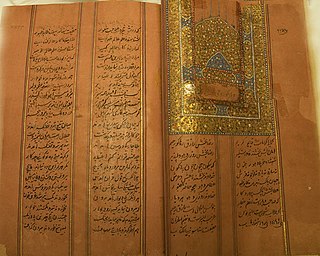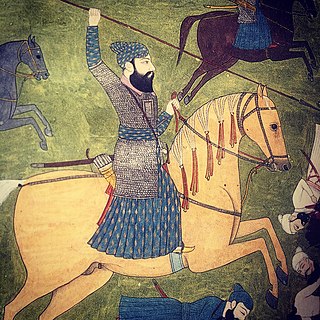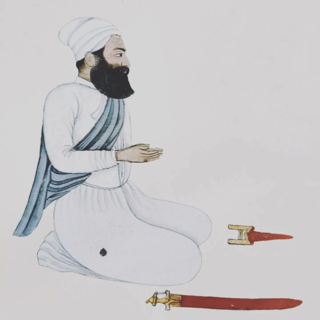An editor has nominated this article for deletion. You are welcome to participate in the deletion discussion , which will decide whether or not to retain it. |
The Battle of Nirmohgarh was fought between Sikhs and the Mughal Empire in 1702.
An editor has nominated this article for deletion. You are welcome to participate in the deletion discussion , which will decide whether or not to retain it. |
The Battle of Nirmohgarh was fought between Sikhs and the Mughal Empire in 1702.
The Imperial Mughal Army was defeated in the bloody Battle of Anandpur (1700). After hearing the news about the defeat of the Mughal Army in the battle, Aurangzeb personally himself sent a fresh army under Wazir Khan against Guru Gobind Singh. Wazir Khan thus proceeded with a large number of troops, reinforced by the Hill Rajas of the Sivalik Hills.[ citation needed ]
Wazir Khan met the Sikhs just outside Anandpur on the banks of the River Sutlej at Nirmohgarh. The Mughals attacked the Guru from one side and the Hill Rajas attacked them from the other side. The fight continued fiercely for the whole day and at night until eventually the combined forces of the Mughals and Hill Rajas were exhausted and were compelled to retreat.[ citation needed ]
The next morning, the Mughals and the Hill Raja's forces restarted the attacking and Guru Gobind Singh, finding himself greatly outnumbered, decided to retire from the place. The enemy troops pursued him and the Sikhs decided to give them another final battle in which the combined forces of Mughals and Hill Rajas were decisively defeated and the Imperial Mughal Army was forced to withdraw after two days of fighting.[ citation needed ]

Guru Gobind Singh was the tenth and last human Sikh Guru. He was a warrior, poet, and philosopher. In 1675, at the age of nine he was formally installed as the leader of the Sikhs after his father Guru Tegh Bahadur was executed by Emperor Aurangzeb. His father was the ninth Sikh Guru. His four biological sons died during his lifetime – two in battle and two executed by the Mughal governor Wazir Khan.
Dal Khalsa was the name of the combined military forces of 11 Sikh misls that operated in the 18th century (1748–1799) in the Punjab region. It was established by Nawab Kapur Singh in late 1740s.

The Takht Sri Darbar Sahib Damdama Sahib, is one of the five takhts or Seat of Temporal Authority of Sikhism, located in Talwandi Sabo, near the city of Bathinda in Bathinda district of Punjab, India. At this place Guru Gobind Singh, the tenth Sikh Guru, prepared the full version of the Sikh scriptures called Sri Guru Granth Sahib in 1705. The other four Takhts are the Akal Takht, Takht Sri Keshgarh Sahib, Takht Sri Patna Sahib and Takht Sri Hazur Sahib.

Ajit Singh, also referred to with honorifics as Sahibzada Ajit Singh or Baba Ajit Singh, was the eldest son of Guru Gobind Singh and the son of Mata Sundari. His younger brothers were Jujhar Singh, Zorawar Singh and Fateh Singh, but they had been born to Mata Jito. He was killed in the Second Battle of Chamkaur along with his brother Jujhar Singh. His other two brothers, Zorawar Singh and Fateh Singh, nine and seven years old, respectively, were bricked alive at Fatehgarh Sahib on order of Wazir Khan, governor of Sirhind-Fategarh.

The Battle of Chamkaur, also known as Battle of Chamkaur Sahib or the Second battle of Chamkaur, was fought between the Khalsa, led by Guru Gobind Singh, and the coalition forces of the Mughals led by Wazir Khan and of Hindu hill chief. Guru Gobind Singh makes a reference to this battle in his letter Zafarnama.
The Battle of Bhangani was fought between Guru Gobind Singh's army and Bhim Chand (Kahlur) of Bilaspur on 18 September 1686 or 1688, at Bhangani near Paonta Sahib. An alliance of Rajput Rajas of the Shivalik Hills participated in the engagement on behalf of Bhim Chand of Bilaspur State's side, including the states of Garhwal and Kangra. It was the first battle Guru Gobind Singh, the tenth Sikh Guru, fought at the age of 19.
The Battle of Anandpur was fought at Anandpur, between the armies of the Sikh Guru Gobind Singh and the Mughal forces aided by the Nawab of Bahawalpur state, Rajas of the Sivalik Hills.

The second siege of Anandpur, also known as the second battle of Anandpur (1704), was a siege at Anandpur, between Sikhs and the Mughal governors, dispatched by Aurangzeb, Wazir Khan, Dilwaar Kahn and Zaberdast Khan, and aided by the vassal Rajas of the Sivalik Hills which lasted from May 1704 to 19 December 1704.

The Saka Sirhindor the Chhotte Sahibzada Saka refers to the killing and martyrdom (Shaheedi) of the two sons of Guru Gobind Singh, named Zorawar Singh and Fateh Singh. The two Sikh children are remembered as the Chhotte Sahibzade. They are believed to have attained martyrdom on 26 December 1704 at the ages of 5(or 6) and 9 respectively. In remembrance of this occasion, the Shaheedi Jor Mela is organised annually at Fatehgarh Sahib Punjab, India, to commemorate the supreme sacrifice at the place of their martyrdom on the 24th to 26 December.

Sirhind is the older name of Fatehgarh Sahib, a city and Sikh pilgrimage site in Punjab, India. It is situated on the Delhi to Lahore Highway. It has a population of about 60,851 . It is now a district headquarters in the state of Punjab; the name of the district is Fatehgarh Sahib.

Banda Singh Bahadur, was a Sikh warrior and a general of the Khalsa Army. At age 15, he left home to become an ascetic, and was given the name Madho Das Bairagi. He established a monastery at Nānded, on the bank of the river Godāvarī. In 1707, Guru Gobind Singh accepted an invitation to meet Mughal Emperor Bahadur Shah I in southern India, he visited Banda Singh Bahadur in 1708. Banda became disciple of Guru Gobind Singh and was given a new name, Gurbaksh Singh(as written in Mahan Kosh), after the baptism ceremony. He is popularly known as Banda Singh Bahadur. He was given five arrows by the Guru as a blessing for the battles ahead. He came to Khanda, Sonipat and assembled a fighting force and led the struggle against the Mughal Empire.

The Battle of Sarsa was fought in 21 December 1704 between the Khalsa and the Mughal Empire.
The Battle of Lohgarh was fought between the First Sikh State, and the Mughal Empire in 1710. The Mughal emperor Bahadur Shah's army moved towards Lohgarh, Bilaspur where they engaged with the Sikhs to capture the fort on 16 December 1710. The battle is noted for its use of guerilla tactics and being a pitched battle.
The first siege of Anandpur was a thirty-five-day-long siege at Anandpur led by the Rajas of the Sivalik Hills and the Gujar and Ranghar tribesmen against the armies of the Sikh under Guru Gobind Singh.
The Battle of Guler was fought between forces led by Sikh Guru Gobind Singh and Mughal forces, aided by the Rajas of the Sivalik Hills.
The First battle of Chamkaur was fought in 1702 between the Sikhs and the Mughals. It resulted in a Sikh victory and the Mughal General Sayyad Beg joining the Sikhs with some troops.

The Hill States–Sikh wars, also known as the Sikh–Pahari Raja wars, was a set of battles and conflicts fought by the Sikhs and the rajas (kings) of the Hill States located in the Sivalik Hills.
The Battle of Anandpur was fought between the Sikh forces led by Guru Gobind Singh and the Hill State forces by Alim and Balia Chand. This was the first major battle fought after the formation of the Khalsa.

Alam Singh Nachna, also called Alim Singh, was a warrior in the army of Guru Gobind Singh, and was a Rajput turned Sikh. Sarup Das Bhalla of Mahima Prakash describes him as one of Guru Gobind Singh's constant and closest companions. He is also known for killing a lion single handedly.
The Battle of Anandpur was fought on 24 February between the Sikh forces led by Guru Gobind Singh and the forces of some Hill States.